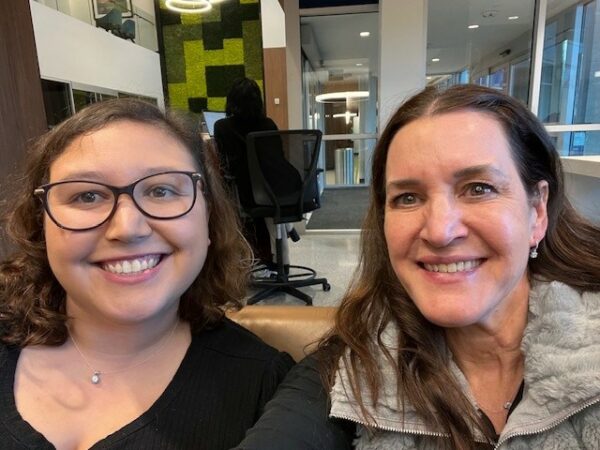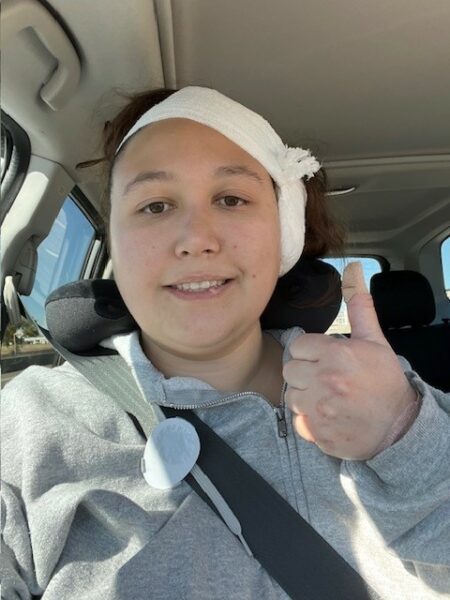Unable to clearly understand her mother speaking in church, Taylor and her family recognized that something was not normal. It was later determined by a hearing test that she had hearing loss – this led to a lack of confidence and the need for accommodations for her as she progressed through her education. With advanced technology, including MRI compatibility*, Taylor was introduced to the Cochlear™ Osia® System, and now her life has changed for the better. Read her story here:
“My journey with hearing loss officially began at a young age, 4 years old specifically. When I was around the age of 2, my mother brought me to the pediatrician to ask why my speech was developing so slowly but the doctor dismissed the concerns at the time and chalked it up to me just being a ‘quiet’ kid and that I would catch up with my peers. And because children are so resilient, I did eventually catch up with my speech development and the concerns disappeared for another year or two.
But one day while sitting in church with my family at 4 years old, I whipped my head ninety degrees as my mother whispered into my left ear. She asked why I moved my head to hear with my other ear and I couldn’t explain, it was just normal for me.
 Learning of a hearing loss diagnosis
Learning of a hearing loss diagnosis
Fast forward a few months and after multiple hearing tests, an MRI, and a consult with a well renowned ear, nose and throat doctor (ENT), my family and I finally had a set diagnosis. I was likely born with a sensorineural unilateral mild to severe hearing loss that was due to a lack of hair cells in the cochlea. By the time the ENT saw me and with the technology at that point, my family was told there were no reasonable options for my hearing loss. So, I grew up with one good ear and another ear that could hear sounds but couldn’t understand speech.
As I grew older, I learned tools and tricks to help me in the myriad of situations I lived through. I sat closer to the front of the class, I always stood on the left side of my family so I could hear them, etc. And while these changes would help, they ate away at my own confidence as I grew into adulthood. It became embarrassing to ask others to make accommodations for me, even if they had no issue with it.
I decided that I needed to learn and educate myself more on my hearing loss and any possible solution I could find. I switched my major in college from education to audiology/speech-language pathology. And through all these new experiences and my education, I did find that technology had made incredible advancements in just fifteen years!
My first full time job after college was with an audiology practice that specializes in hearing aids. They were a wonderful support network, and it was inspiring to see others with hearing loss making strides to better their hearing. I tried a regular hearing aid at first but quickly realized within minutes that I wouldn’t be able to tolerate it. A CROS hearing aid (which took sound from the bad side and sent it to my good ear) was the next step, and boy was I resistant to it at first. I hated having things in both my ears, the maintenance was frustrating at times and hearing aids didn’t seem to have a long lifespan.
A short-term solution, and a long-term solution
This transition opened a new avenue for me – I could finally ‘hear’ on the left side of my head! My family noticed that I was happier, but I still felt as though I was missing something. I felt as though this was only a short-term solution; a band aid fix. Eventually my hearing aids were out of warranty and quit working altogether. I was left, once again, in a world where I needed more accommodations and felt constantly frustrated with myself. It was the last straw for me, so I dove into researching all my options again.
As I grew in my career, I eventually found myself learning about implantable solutions. And so, I was introduced to Cochlear. The moment I learned about Cochlear’s hearing solutions, I was ecstatic to say the least.
After a few months of talking with my husband, my audiologist and my ENT, I decided upon the newest Cochlear Osia System1. I had read wonderful things and it was an implantable solution that didn’t require physical maintenance at the surgical site. The bonus, it was MRI compatible23, which was a huge relief for me as I had already had around four MRI’s at that point. I wanted a solution that would allow me to hear without having two hearing aids, would last longer, and would allow me to still stream4 my music. When activation day came, it was one of the best moments of my life. The moment they turned on the Osia Sound Processor, it was as if everything felt right. I was able to have my family sit on my bad side and speak to me without turning. I was able to go to a restaurant that night and order my own meal even as the people around me talked loudly. I was able to drive home from that activation singing my lungs out in the car as my husband watched with a smile.
 Advanced technology making a large impact
Advanced technology making a large impact
Having the Osia Sound Processor has been such a game changer for me and I am still in love with it to this day. It was a challenge at first to get used to it; but the direct streaming**** capabilities helped so much, I found myself wearing the device even if I was home alone in silence. Streaming music and my favorite shows allowed me to feel confident again and excited that I would never have to buy another set of headphones!
The Mini Microphone 2+ wireless accessory has also been a blessing, as I can give it to my husband if I am outside and he can gain my attention without scaring me half to death. With my new Osia Sound Processor, I feel like anything is possible and I’m not at such a disadvantage anymore. I’ve been confident enough to go for new roles in my career and am looking forward to anything life throws at me.
For once, I don’t feel as though I have to be embarrassed about my hearing loss and I can’t thank Cochlear enough for that.”
The Osia System’s MRI compatibility helps those just like Taylor, who have been diagnosed with hearing loss. If you are in a similar scenario, learn about your candidacy options!
- In the United States, the Osia 2 System is cleared for children ages five and older. In Canada, the Osia 2 System is approved for children ages five and older
- Prior to receiving an MRI, please consult with your clinician about proper precautions.
- Cochlear Osia implants are MR Conditional, meaning they have demonstrated safety in Magnetic Resonance Imaging (MRI) environment within defined conditions. Always read the instructions for use and discuss with your doctor before undertaking any MRI procedure.
- For a full list of smartphone and app compatible devices, visit: www.cochlear.com/compatibility.